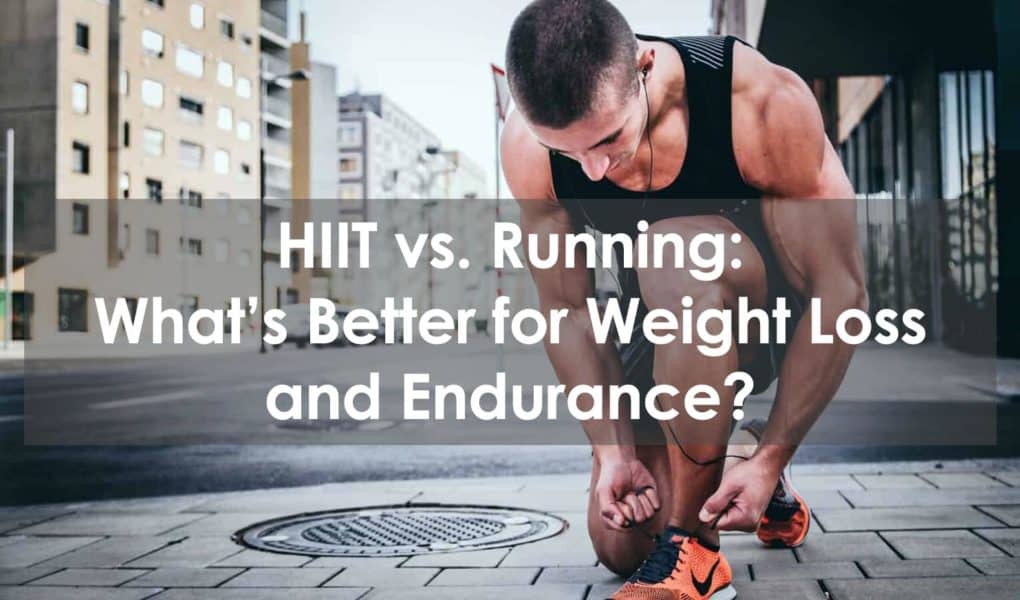When it comes to weight loss, we all know exercise is the first thing we should be doing. We know we need to get our bodies moving to burn calories and help us shed those lbs. But, what exercise should we be doing? What type of exercise is going to be the most beneficial in our weight loss journey?
Over recent years, there’s been an overload of information when it comes to exercise training. There are now 101 ways to exercise, different methods, sports, and equipment has made exercise confusing, leaving people confused about what exercise is right for them and their individual goals.
We’re going to take a look at two of the most popular forms of exercise; HIIT and running, and analyze which is better for weight loss and endurance.
HIIT vs Running
Introduction to HIIT
High-intensity interval training, also known as ‘HIIT’ is an interval-based form of exercise. HIIT workouts consist of short bursts of exercise performed at near maximal efforts, at >80% of our maximum heart rate, followed by periods of rest. During HIIT workouts, you won’t be working out for long, but when you are moving it will be at a very high intensity.
To ensure you get the benefits of HIIT you need to be making sure you’re hitting that high intensity. When it comes to HIIT workouts, it really is a matter of quality over quantity. As a general rule of thumb, the greater the intensity during work periods, the shorter the total duration, and the longer rest periods.
Who is HIIT For?
A HIIT workout can be performed by most people but isn’t safe for everyone. Due to the high-intensity nature of HIIT, it is considered dangerous to certain populations including those with heart complications, and pregnant women.
Additionally, HIIT might be suitable for a range of people, but how you structure a HIIT workout will depend on a magnitude of factors such as training status, injuries, weight, physical capabilities, and safety.
If you’re overweight you will need to identify which exercises are suitable, and at what intensity, things like jumping squats could cause more harm than good. Working with a professional will help you assess what is best for you.
Benefits of HIIT in Endurance Training
- Improved Cardiovascular Capacity: HIIT training increases your mitochondria capacity. Mitochondria, also known as the powerhouse of the cell, provides us with energy during exercise.
- Long-Term Physical Adaptations: Improved cardiorespiratory system due to lowered heart rate, blood pressure, increased blood vessels, and higher stroke volumes.
Benefits of HIIT in Weight Loss Training
- Reduced Absolute Fat Mass: In a recent research review article (Viana et al. 2019), interval training and moderate-intensity exercise resulted in similar similar body fat loss percentage changes. However, interval training resulted in larger reductions in absolute fat mass.
- Time Effective: HIIT has developed significant popularity due to its time efficiency. HIIT sessions deliver similar benefits to steady-state cardio sessions while taking a fraction of the time. A good HIIT session should take no longer than 20 minutes to perform, making it easy to fit into the busiest of lives. If time is a limiting factor in your exercise regime, HIIT provides a suitable option.
- Afterburn Effect: HIIT training causes an afterburn effect, known as post-exercise oxygen consumption. The effect continues to burn calories even after you’ve finished exercising. However, the effect isn’t always as drastic as we’re lead to believe.
Disadvantages of HIIT
Like anything, HIIT comes with its own pros and cons. Let’s take a look at when a HIIT workout might be doing us more harm than good:
- Inappropriate Increase in Volume and Intensity: Many of us are guilty of jumping into new exercises too quickly, without considering our current fitness levels and capabilities. HIIT is known for its fast, intense nature; therefore, we are completing a lot of repetitions in a short space of time. If we are not used to this volume and intensity, we can be more susceptible to muscle strains and tendinitis. Taking on too much too soon will only lead to injury complications. Ensure you are applying safe progressions and sufficient recovery.
- Lack of Recovery: High-intensity exercise puts significant strain on our body, making proper recovery vital for both our health and performance. For the general population, it is recommended HIIT sessions are performed two times a week. However, many of us like working out more than this. Adding in more sessions without sufficient recovery can lead to stagnated progress and increased risk of injury. Additionally, if you’re also strength training, the intensity of HIIT sessions can limit strength progress.
Getting Started with HIIT
Training HIIT can be performed in many different ways, you can manipulate the work time, rest time, total number of rounds, and exercises. As long as you are working at >80% of your maximum heart rate during work time, anything can be HIIT. To determine what is best for you and your goals consult your physician and exercise professional.
Introduction to Running
Running can be performed in a range of exercise domains; sprint intervals, long-distance, or even HIIT. However, running is commonly performed as a form of moderate-intensity continuous steady-state cardio. Therefore, for the purpose of this article, when we refer to running, we are referring to moderate-intensity continuous steady-state cardio. Moderate-intensity exercise is a continuous bout of exercise performed at 55-70% of our maximum heart rate, without any periods of rest. During distance running, workouts you could be traveling from a 5km, all the way up to an ultra marathon.
Who is Running For?
Like HIIT training, running isn’t suitable for everyone. While most of the population is fortunate enough to perform the movement of running, it can cause more harm than good to some individuals. Running is a relatively high-impact exercise, which can be rough on the joints. Individuals with weak bones, high body mass, and injuries would benefit from lower-impact exercises such as swimming or cycling.
Benefits of Running in Endurance Training
The physiological and cardiovascular heart health benefits of running in endurance are actually very similar to HIIT training:
- Improved Cardiovascular Capacity: Running increases your mitochondria capacity. Mitochondria, also known as the powerhouse of the cell, provides us with energy during exercise.
- Long-Term Physical Adaptations: Improved cardiorespiratory system due to lowered heart rate, blood pressure, increased blood vessels, and higher stroke volumes.
- Greater Specificity: If you’re looking to get better at continuous steady-state cardio, running helps your body and mind get comfortable with working for long continuous periods of time. It can be physically and mentally draining to be continuously exercising, therefore you need to also train in this aspect of endurance exercise.
Benefits of Running in Weight Loss Training
- Duration: As mentioned, running is a moderate-intensity exercise, meaning you can work for a longer period of time. Long workouts have the capacity to burn a lot of calories. A high-calorie burn results in weight loss. HIIT training also has a high-calorie burn, but the high-intensity nature causes rapid fatigue, preventing you from long sessions.
Disadvantages of Running
- Time Consuming: Running sessions can range anywhere between 30 minutes to 4 hours. Physical adaptations take longer when running due to lower intensity. Many people prefer a lower intensity and find high-intensity training uncomfortable, that’s totally okay. But, longer sessions are much harder to fit into your everyday life.
- High Impact: Running produces an impact with each step to the floor. If you imagine how many times you’re foot is hitting the floor during each run, that’s a lot of repetitive impacts. If your body is prepared to take this repetitive impact, running will only help increase your fitness and health. However, if you have injuries, weak bones, or a high body mass, all this repetitive impact can put unnecessary stress on your joints, leading to an increased risk of injury.
Getting Started with Running
When it comes to running, there are two things you need to focus on; pace and duration. These two factors will depend on your running experience and physical capabilities. Your pace and duration must keep you in the 55-70% maximum heart rate range. To determine what is best for you and your goals consult your physician and exercise professional.
Conclusion
HIIT vs Running: What’s Better For Weight Loss and Endurance? Truth is, neither is overall better or worse, they both have their pros and cons. It really depends, it depends on your physical ability, preferences, time availability, injuries, and a whole load of other reasons.
Both HIIT and running have their advantages and disadvantages. They both are effective in improving endurance and aiding weight loss, therefore both have a place in the fitness industry. It really comes down to what you can and can’t do, and what fits you and your lifestyle.
If you want a mix of both in your exercise routines, that’s also perfectly fine. Find whatever works for you. The best way to work out what’s right for you is to consult your physician and exercise professional. They will assess your personal capabilities and recommended the most sustainable, safest, enjoyable forms of exercise.
Frequently Asked Questions
Is HIIT better than running?
In terms of weight loss and endurance, no. But, this answer really depends on what is meant by ‘better’. If you prefer running to HIIT, then running is better for you. If you have knee injuries, and upper body focused HIIT session would probably be better for you. It’s all a matter of your ability and preference.
Is HIIT more effective than cardio?
HIIT is in its own right a form of cardio exercise. Cardio workouts include continuous steady state cardio and interval training – including HIIT. HIIT is not more effective in terms of weight loss and endurance gain. Again, it depends on your personal circumstances.
What’s better for losing weight running or HIIT?
Both forms of exercise provide an increase in calorie expenditure, leading to weight loss. However, calorie expenditure will depend on intensity and duration. As we’ve mentioned, HIIT will fatigue you much faster than running. Therefore, there is the capacity to burn more calories during the long run. However, bear in mind a long duration run will require more calorie intake to ensure we are replenished. So, although we might be able to burn more during a run, we must consider how we’re refueling to lose weight at a healthy pace.
Should you run and do HIIT on the same day?
No, running and performing HIIT simultaneously is not recommended for the vast majority of the population. HIIT is very high intensity and will tax your body significantly. Take sufficient rest between exercise sessions. Not taking enough rest leads to increased risk of injury and decreased physical performance. If you want to perform both HIIT and running, do so with sufficient rest and recovery. Do not allow HIIT sessions to exceed two times a week within your workout routine.







